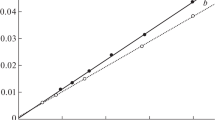Summary
The most important chromatography terms we are concerned with frequently are efficiency and selectivity. Through appropriate redefinitions the relation between these terms and the resolution becomes more obvious. To evaluate a particular separation the measurement of the behaviour of an unretained compound is not required; with common measurements on the actual chromatogram it is easily possible to calculate simple rations, the efficiency and the selectivity, so that different systems can be compared.
Similar content being viewed by others
Abbreviations
- Dm :
-
mass distribution ratio (‘capacity factor’)
- Dm2 :
-
mass distribution ratio of component 2
- E:
-
efficiency of chromatography, defined in eq. (2)
- Emax :
-
theoretical maximum in efficiency that can be realized with given dimensions of the separation system
- h:
-
variance generated per unit length (‘height equivalent to a theoretical plate’, HETP)
- n:
-
theoretical plate number
- Q:
-
relative difference of distribution ratios, defined in eq. (10)
- R:
-
dragging, fraction of component in mobile phase
- R2 :
-
dragging of component 2
- R3 :
-
peak resolution, using peak width of component emerging later
- S:
-
selectivity of system (relative retention time difference) eq. (4)
- tR :
-
retention time, not adjusted (from start)
- tR2 :
-
retention time of component 2
- tM :
-
retention time of unretained component (holdup time)
- VR :
-
retention volume, total
- wb :
-
peak width at base [2]
- wb2 :
-
peak width at base of component 2
- α:
-
relative distribution ratio (‘relative retention’)
- α* :
-
relative retention time [1]
- Δt:
-
distance between peak centres
- σ:
-
standard deviation of peak elution curve
References
L. S. Ettre, J. Chromatogr.198, 229 (1980).
L. S. Ettre, J. Chromatogr.165, 235 (1979).
International Union of Pure and Applied Chemistry, Pure Appl. Chem.37, 447 (1974).
R. Delley, G. Székely, Chimia32, 261 (1978).
J. J. Kirkland, W. W. Yau, H. J. Stoklosa, C. H. Diiks, J. Chromatogr. Sci.15, 303 (1977).
R. Delley, Chromatographia9, 10 (1976).
J. F. Parcher, D. M. Johnson, J. Chromatogr. Sci.18, 267 (1980).
R. Groh, I. Halász, J. Chromatogr.199, 23 (1980).
Author information
Authors and Affiliations
Additional information
Symbol used with the same meaning in the IUPAC recommendations [3].
Symbol not in the IUPAC recommendations but compatible with it.
Rights and permissions
About this article
Cite this article
Delley, R. Redefinition of basic chromatography terms. Chromatographia 15, 167–171 (1982). https://doi.org/10.1007/BF02261533
Received:
Accepted:
Issue Date:
DOI: https://doi.org/10.1007/BF02261533




